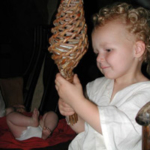Autor: Dorothee Olthof, Jaap Hogendoorn
Quelle & Copyright: Archeon
Did a Dutch 14th century city stink?
That is difficult to answer because: what is stinking actually? It smelled different in a medieval town than nowaydays. Almost all houses had a fire place where wood was burnt. Poor people would burn turf (smells more). Besides for heating, the fires were meant for cooking as well. The blacksmith would forge on a coal fire. But there were no cars with stinking exhaust fumes. There were some things the medieval people thought smelled bad, like the leather tanners or the textile dyers. These were commanded to practice their activities at the edge of the cities. Urine was not thrown onto the streets but saved and sold to these people. Every house was supposed to have a secrete (toilet), they were usually put in the back garden. Some cities had already appointed garbage collectors by the 14th century. There were strict laws against polluting the city and its channels. Dirt was not allowed to be thrown onto the streets or in the channel. In the 14th century, in Dordrecht, a bleeder lady (a woman specialised in letting blood form people) was banned from the city for a period of 100 years and 1 day because she had thrown a bucket of blood into a channel. The channels needed to remain clean as the beer brewers used this water. Nobody wants to sit in the stench, not even medieval people.
Hans Siebelink, medieval city watch, Archeologisch Themapark Archeon (NL)
Stonk het in een 14e-eeuwse Hollandse stad?
Daar is niet direct een antwoord op te geven, want wat is stinken? Het rook in een middeleeuwse stad anders dan nu. Bijna alle huizen hadden een haard waar hout werd verbrand. De arme mensen verbrandden turf (stinkt meer). Die vuren waren behalve voor verwarming ook om op te koken. De smid smeedde bij een vuur van steenkool. Maar er waren nog geen auto’s met stinkende uitlaatgassen. Er waren ook dingen die de middeleeuwers vonden stinken, bijvoorbeeld de leerlooiers of lakenververs. Die moesten buiten of aan de rand van de stad hun beroep uitoefenen. Urine werd niet op straat gegooid maar bewaard en verkocht aan leerlooiers en ververs. Ieder huis moest een secreet (wc) hebben, deze stonden meestal achter op het erf. Sommige steden hadden in de 14e eeuw al stadsvuilnislieden in dienst. Er waren strenge wetten tegen de vervuiling van de stad en de grachten. Vuil mocht niet op straat of in de gracht gegooid worden. In de 14e eeuw werd in Dordrecht een laadster (een vrouw die gespecialiseerd was in aderlaten) voor 100 jaar en 1 dag verbannen uit de stad omdat ze een bak met bloed in de stadsgracht had gegooid. De grachten moesten schoon blijven, omdat de bierbrouwers daar het water uit haalden. Niemand wil in de stank zitten, ook de middeleeuwers niet.
Hans Siebelink, medieval city watch, Archeologisch Themapark Archeon (NL)








